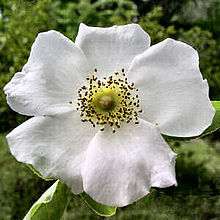Rosa laevigata
| Rosa laevigata | |
|---|---|
 | |
| Scientific classification | |
| Kingdom: | Plantae |
| (unranked): | Angiosperms |
| (unranked): | Eudicots |
| (unranked): | Rosids |
| Order: | Rosales |
| Family: | Rosaceae |
| Genus: | Rosa |
| Species: | R. laevigata |
| Binomial name | |
| Rosa laevigata Michx. | |
Rosa laevigata, the Cherokee rose,[1] is a white, fragrant rose native to southern China and Taiwan south to Laos and Vietnam, and invasive in the United States.
Description
It is an evergreen climbing shrub, scrambling over other shrubs and small trees to heights of up to 5–10 metres (16–33 ft). The leaves are 3–10 centimetres (1.2–3.9 in) long, with usually three leaflets, sometimes five leaflets, bright glossy green and glabrous. The flowers are 6–10 centimetres (2.4–3.9 in) diameter, fragrant, with pure white petals and yellow stamens, and are followed by bright red and bristly hips 2–4 centimetres (0.79–1.57 in) diameter. The flower stem is also very bristly.
Cultivation
The species was introduced to the southeastern United States in about 1780, where it soon became naturalized, and where it gained its English name.
Cultural references
The flower is commonly associated with the Trail of Tears, the forced relocation of Native Americans in the southeastern United States. Its white petals are said to represent the tears the Cherokee women shed[2] during the period of great hardship and grief throughout US government-forced march from the Cherokees' home to U.S. forts, such as Gilmer. The flower's gold center is said to symbolize the gold taken from the Cherokee tribe.[3]
It is the state flower of Georgia.
The flower figures prominently in several episodes of AMC's television series The Walking Dead which is set in Georgia. A second season episode called Cherokee Rose mentioned the trail of tears myth about the flower.
References
- ↑ "Rosa laevigata". Natural Resources Conservation Service PLANTS Database. USDA. Retrieved 23 October 2015.
- ↑ "Legend of the Cherokee Rose". Powersource.com. Retrieved 2011-12-05.
- ↑ "The Trail of Tears - Cherokee Indians forcibly removed from North Georgia". Ngeorgia.com. 2007-06-05. Retrieved 2011-12-05.